Solid Waste Management in Ho Chi Minh City, Vietnam: Moving towards a Circular Economy?
Abstract
:1. Introduction
- Valorization of the landfill gas of Gò Cát landfill;
- Valorization of materials from Gò Cát landfill body after landfill mining;
- Valorization of energy produced from Gò Cát landfill body after landfill mining;
- Land recycling and valorization of the land after deconstruction of Gò Cát landfill; and
- Valorization of Gò Cát landfill surface through a biomass utilization plant in case the landfill remains.
2. Materials and Methods
- Analysis of the WM system in HCMC through the DPSIR framework in order to get insights in drivers and pressures in a holistic way;
- Waste flow analysis on the HCMC level, through an on-site data collection in collaboration with the operator CITENCO;
- Investigation of the waste composition 8 years after closure of Gò Cát landfill including heating value determination of the waste according to DIN 51900;
- Data collection on the metabolism of HCMC metropolitan area and the ecological footprint;
- Variant assessment on valorization potential of the Gò Cát landfill site with the scope to create financial benefit in order to improve the WM system in HCMC;
- Impact assessment for the environmental factors at Gò Cát landfill and risk assessment on the long term; and
- SWOT analysis of the existing situation in order to evaluate existing strengths and future opportunities.
3. Results
3.1. Analysis of the WM System in HCMC through the DPSIR Framework
3.2. Variant Assessment for the Reutilization of Gò Cát Landfill Site as Small Scale Sample for Material and Land Recycling
3.2.1. Valorization of Landfill Gas from the Existing Landfill Body
3.2.2. Assessment of the Feasibility of Enhanced Landfill Mining
- Organic wastes formed the highest percentage (81.4%), represented by food waste (70.8%), by textiles (1.8%), wood (1.2%), yard garbage (1.2%), rubber (0.4%), and leather (0.3%).
- Plastic formed the second highest proportion (16.0%). Among the plastic materials, the fractions were nylon (13.8%), foam boxes (0.7%), multi-component plastic (0.2%) and plastic bottles (PET).
- Paper was included with an average proportion of 1.0%, caused by household paper and magazine printing paper (0.6%) as well as cardboard and corrugated cardboard (0.4%).
- CDW formed a very small proportion such as ferrous metals (0.2%), non-ferrous metals (0.02%), glass (0.3%), and potential hazardous other wastes (0.1%).
3.2.3. Assessment of the Feasibility of the Biomass Use at the Capped Gò Cát Landfill Site
- (1)
- Professional landfill capping, cultivation of energy crops on the landfill cover and utilization of the biomass together with other organic matter, e.g., biodegradable waste (food leftovers), agricultural and industrial residues.
- (2)
- Installation and operation of a biomass converter for the generation of biogas. The produced biogas would be used to generate energy in a Combined Heat and Power plant (CHP).
4. Discussion
5. Conclusions
Acknowledgments
Author Contributions
Conflicts of Interest
References
- General Statistics Office of Vietnam (GSO). Statistical Handbook of Vietnam; GSO: Ha Noi, Vietnam, 2014.
- Schwartze, F.; Gravert, A.; Eckert, R.; Schinkel, U.; Kersten, R. Research News for Climatic Compliant Cities: The Case of Ho Chi Minh City, Vietnam. In Resilient Cities: Cities and Adaptation to Climate Change, Proceedings of the Global Forum 2010, Local Sustainability I; Otto-Zimmernann, K., Ed.; Springer: Dodrecht, The Netherlands, 2010; pp. 339–348. [Google Scholar]
- Ho Chi Minh City Department of Natural Resources and Environment (HCMC DONRE). Report on Solid Waste Management in Ho Chi Minh City; HCMC DONRE: Ho Chi Minh City, Vietnam, 2014.
- Tran, T.M.D.; Oanh, L.T.K. Possibilities and Challenges to Approach Zero-Disposal of Biodegradable Organic Domestic Solid Waste in Ho Chi Minh City, Vietnam. IJISET 2015, 2, 668–675. [Google Scholar]
- Labaye, A.; Brugmann, J.; Bao, T.; Nguyen, V.P.; Ly, K.T.T.; Nguyen, A.T.; Storch, H.; Schinkel, U. Reality Check: Ho Chi Minh City, Vietnam. In Resilient Cities 2: Cities and Adaptation to Climate Change, Proceedings of the Global Forum 2011, Local Sustainability 2; Otto-Zimmernann, K., Ed.; Springer: Dodrecht, The Netherlands, 2011; pp. 367–376. [Google Scholar]
- Asian Development Bank. Urban Metabolism of Six Asian Cities; Asian Development Bank: Mandaluyong City, Philippines, 2014. [Google Scholar]
- Wust, S.; Bolay, J.C.; Du, T.T.N. Vietnam Metropolization and the Ecological Crisis: Precarious Settlements in Ho Chi Minh City. Environ. Urban. 2002, 14, 211. [Google Scholar] [CrossRef]
- Oanh, L.T.K. SURMAT Decision Support Tool to Select Municipal Solid Waste Treatment Technologies, Case Study in Ho Chi Minh City, Vietnam. Ph.D. Thesis, Wageningen University, Wageningen, The Netherlands, 2012. [Google Scholar]
- Dung, K.M. Assessment of Effective Economic Environment—Proposed Feasibility Mining Scenarios after Gò Cát Landfill Site Stops Receipting of Garbage. Bachelor’s Thesis, IUH HCMC, Institute for the Environmental Science, Engineering and Management, Ho Chi Minh, Vietnam, 2015. [Google Scholar]
- Nguyen, T.V. Solid waste separation at source: Necessary and sufficient condition for waste management in Ho Chi Minh. Van Lang University. Int. J. Environ. Sci. Sustain. Dev. 2012, 1, 1–9. [Google Scholar]
- Center for Environmental Technology and Management (CENTEMA). The Report on Data Collection on Solid Waste Management in Ho Chi Minh City, Vietnam; CENTEMA: Ho Chi Minh, Vietnam, 2009. [Google Scholar]
- Braungart, M.; McDonough, W. Cradle to Cradle. Remaking the Way We Make Things; North Point Press: New York, NY, USA, 2002. [Google Scholar]
- Organization for Economic Co-Operation and Development (OECD). OECD Core Set of Indicators for Environmental Performance Reviews e a Synthesis Report by the Group on State of the Environment, Environmental Monographs; Organization for Economic Co-Operation and Development (OECD): Paris, France, 1993; Volume 83. [Google Scholar]
- David, F. Strategic Management, 4th ed.; Macmillan Publishing Company: New York, NY, USA, 1993. [Google Scholar]
- Helms, M.M.; Nixon, J. Exploring SWOT analysis—Where are we now?: A review of academic research from the last decade. J. Strategy Manag. 2010, 3, 215–251. [Google Scholar] [CrossRef]
- Hoornweg, D.; Bhada-Tata, P. What a Waste—A Global Review of Solid Waste Management, Urban Development Series Knowledge Papers, Issued by the World Bank. Available online: https://www.google.de/?gws_rd=ssl#q=URBAN+DEVELOPMENT+SERIES+%E2%80%93+KNOWLEDGE+PAPERS+waste+management (accessed on 20 January 2017).
- Global Footprint Network National Footprint Accounts 2016—World Development Indicators, Data Base from The World Bank (2016) and U.N. Food and Agriculture Organization. Available online: http://www.footprintnetwork.org/ecological_footprint_nations/ (accessed on 3 January 2017).
- Duong, D. HCMC Market Insights—Q1 2015, CBRE—Commercial Real Estate Services. Available online: https://www.cbrevietnam.com/Vietnam-Property/pressrelease/cbre-releases-q1-2015-quarterly-report-highlights-for-ho-chi-minh-city-market (accessed on 3 January 2017).
- Kennedy, C.A.; Cuddihy, J.; Engel Yan, J. The changing metabolism of cities. J. Ind. Ecol. 2007, 11, 43–59. [Google Scholar] [CrossRef]
- Green Growth and Low Carbon Emissions, Ho Chi Minh City Climate Change Bureau. 2014. Available online: http://www.gec.jp/citycoop/osaka-hcm-lcc/en/support/event140214_hcm_en.pdf (accessed on 3 January 2017).
- The Prime Minister of the Socialist Republic of Vietnam (2009) Approving the National Strategy on Integrated Solid Waste Management up to 2025 and Vision to 2050, No. 2149/QD-TTg, Ha Noi. 2009. Available online: http://www.moc.gov.vn/web/guest/legal-documents/-/legal/TB4r/en_US/18/55968/55213 (accessed on 3 January 2017).
- Ho Chi Minh City Department of Natural Resources and Environment (HCMC DONRE). The Master Plan of MSWM System of HCMC for the Period of 2008–2020 (in VIETNAMESE: Quan ly Tong the he Thong Quan ly Chat Thai ran Thanh pho Ho Chi Minh, Giai doAn 2008–2020); HCMC DONRE: Ho Chi Minh, Vietnam, 2006.
- Hermann, R.; Wolfsberger, T.; Pomberger, R.; Sarc, R. Landfill mining: Developing a comprehensive assessment method. Waste Manag. Res. 2016, 34, 1157–1163. [Google Scholar] [CrossRef] [PubMed]
- Rada, E.C.; Ragazzi, M.; Stefani, P.; Schiavon, M.; Torretta, V. Modelling the potential biogas productivity range from a MSW landfill for its sustainable exploitation. Sustainability 2015, 7, 482–495. [Google Scholar] [CrossRef]
- Landfill Methane Outreach Program. LFG Energy Project Development Handbook; United States Environmental Protection Agency: Washington, DC, USA, 2015.
- Morelli, J. Landfill reuse strategies. Biocycle 1990, April, 60–61. [Google Scholar]
- Krook, J.; Svensson, N.; Eklund, M. Landfill mining: A critical review of two decades of research. Waste Manag. 2012, 32, 513–520. [Google Scholar] [CrossRef] [PubMed]
- Jones, P.T.; Geysen, D.; Tielemans, Y.; van Passel, S.; Pontikes, Y.; Blanpain, B.; Quaghebeu, M.; Hoekstra, N. Enhanced Landfill Mining in view of multiple resource recovery: A critical review. J. Clean. Prod. 2012. [Google Scholar] [CrossRef]
- Brunner, P.H.; Rechberger, H. Waste to energy—Key element for sustainable waste management. Waste Manag. 2015, 37, 3–12. [Google Scholar] [CrossRef] [PubMed]
- Leitfaden zum Enhanced Landfill Mining. Available online: https://www.ifeu.de/abfallwirtschaft/pdf/Leitfaden_Enhanced_Landfill_Mining_final_Mai-2016.pdf (accessed on 3 January 2017).
- Waste Framework Directive, or Directive 2008/98/EC of the European Parliament and of the Council of 19 November 2008 on Waste and Repealing Certain Directives. Available online: http://eur-lex.europa.eu/legal-content/EN/ALL/?uri=CELEX:32008L0098 (accessed on 3 January 2017).
- Bernhard, A.; Domenig, M.; Reisinger, H.; Walter, B.; Weißenbach, T. Deponierückbau—Wirtschaftlichkeit, Ressourcenpotenzial und Klimarelevanz; Bericht im Auftrag der Umweltbundesamt GmbH: Wien, Austria, 2012. (In German) [Google Scholar]
- Krüger, M.; Becker, B.; Dehoust, G.; Reinhardt, J.; Knappe, F.; Breitenstein, A.; Kieckhäfer, K.; Spengler, T.S. Entscheidungsunterstützung und Handlungsempfehlungen. Available online: https://www.ifeu.de/abfallwirtschaft/pdf/Leitfaden_Enhanced_Landfill_Mining_final_Mai-2016.pdf (accessed on 3 January 2017).
- Breitenstein, A.; Kieckhäfer, K.; Spengler, T.S. Ökonomische Bewertung. Available online: https://www.ifeu.de/abfallwirtschaft/pdf/Leitfaden_Enhanced_Landfill_Mining_final_Mai-2016.pdf (accessed on 3 January 2017).
- Wanka, S.; Münnich, K.; Zeiner, A.; Fricke, K. Landfill Mining, Nassmechanische Aufbereitung von Feinmaterial in Müll und Abfall; Erich Schmidt Verlag: Berlin, Germany, 2016. (In German) [Google Scholar]
- Van Passel, S.; Dubois, M.; Eyckmans, J.; de Gheldere, S.; Ang, F.; Jones, P.T.; Van Acker, K. The economics of enhanced landfill mining: Private and societal performance drivers. J. Clean. Prod. 2012, 55, 92–102. [Google Scholar] [CrossRef]
- Mosberger, L.; Schmid Lüdi, K.; Zweifel, H.-R.; Binzegger, J. Energie aus Abfall: Deponierückbau; Umweltperspektiven 6/2016; Galledia Verlag: Flawil, Schweiz, 2016; pp. 21–23. [Google Scholar]
- Gerth, A.; Hebner, A.; Kopielski, K.; Schneider, P. Nachnutzung des Deponiestandortes Gò Cát in Ho Chi Minh City, Vietnam. In Deponieworkshop Liberec-Zittau 2016 “Die Deponie als letzte Möglichkeit”; Technical University of Liberec: Liberec, Chech Republic, 2016; pp. 187–198. [Google Scholar]
- McKendry, P. Energy production from biomass (part 1): Overview of biomass. Bioresour. Technol. 2002, 83, 37–46. [Google Scholar] [CrossRef]
- Rutherford, I.; Heath, M.C. The Potential of Miscanthus as a Fuel Crop; ETSU Report ETSU B 1354; Advanced Driver Assistance Systems (ADAS): Bedford, UK, 1992. [Google Scholar]
- McLaughlin, S.B.; Samson, R.; Bransby, D.; Weislogel, A. Evaluating physical, chemical and energetic properties of perennial grasses as biofuels. In Proceedings of the BIOENERGY’96, Nashville, TN, USA, 15–20 September 1996.
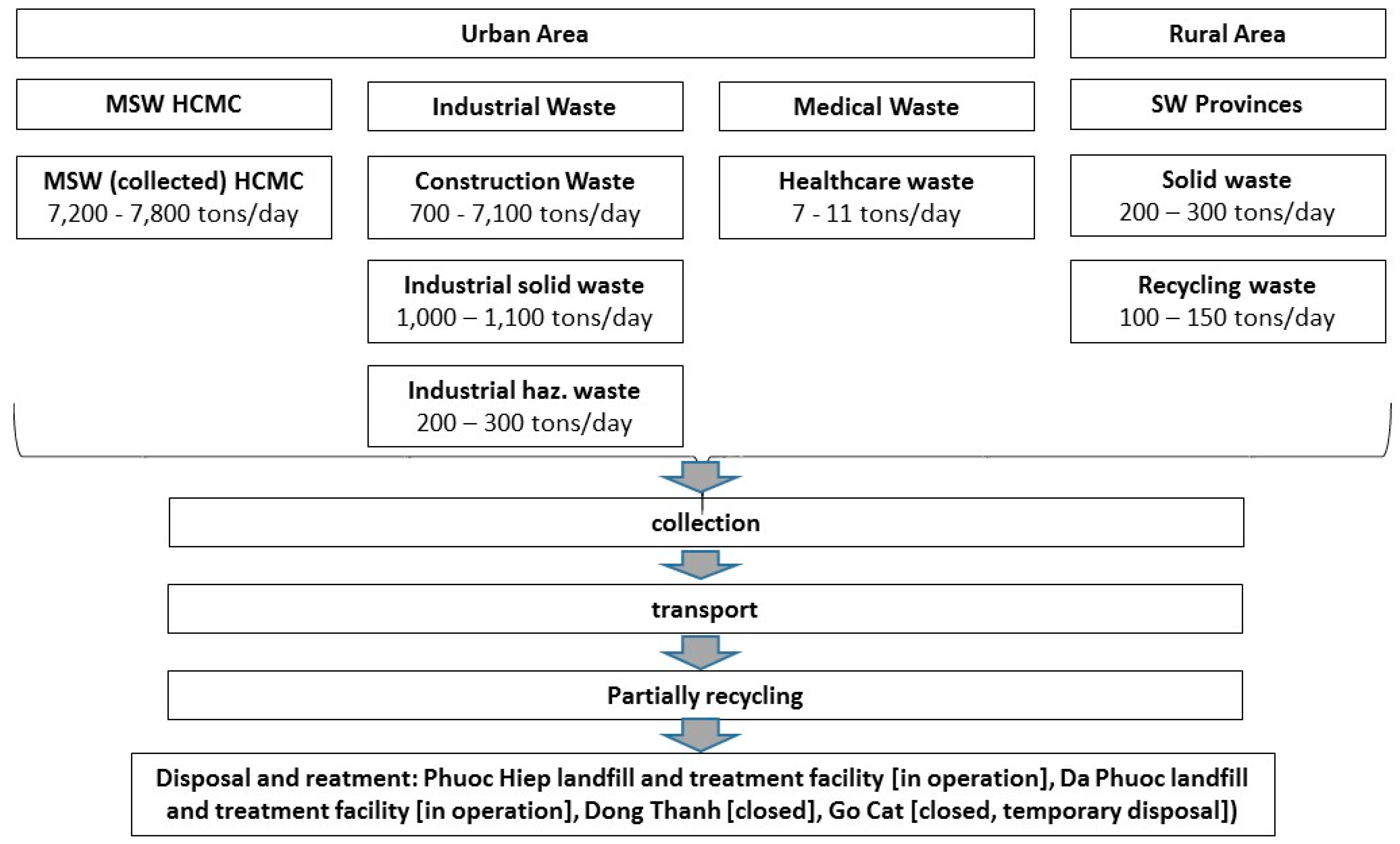
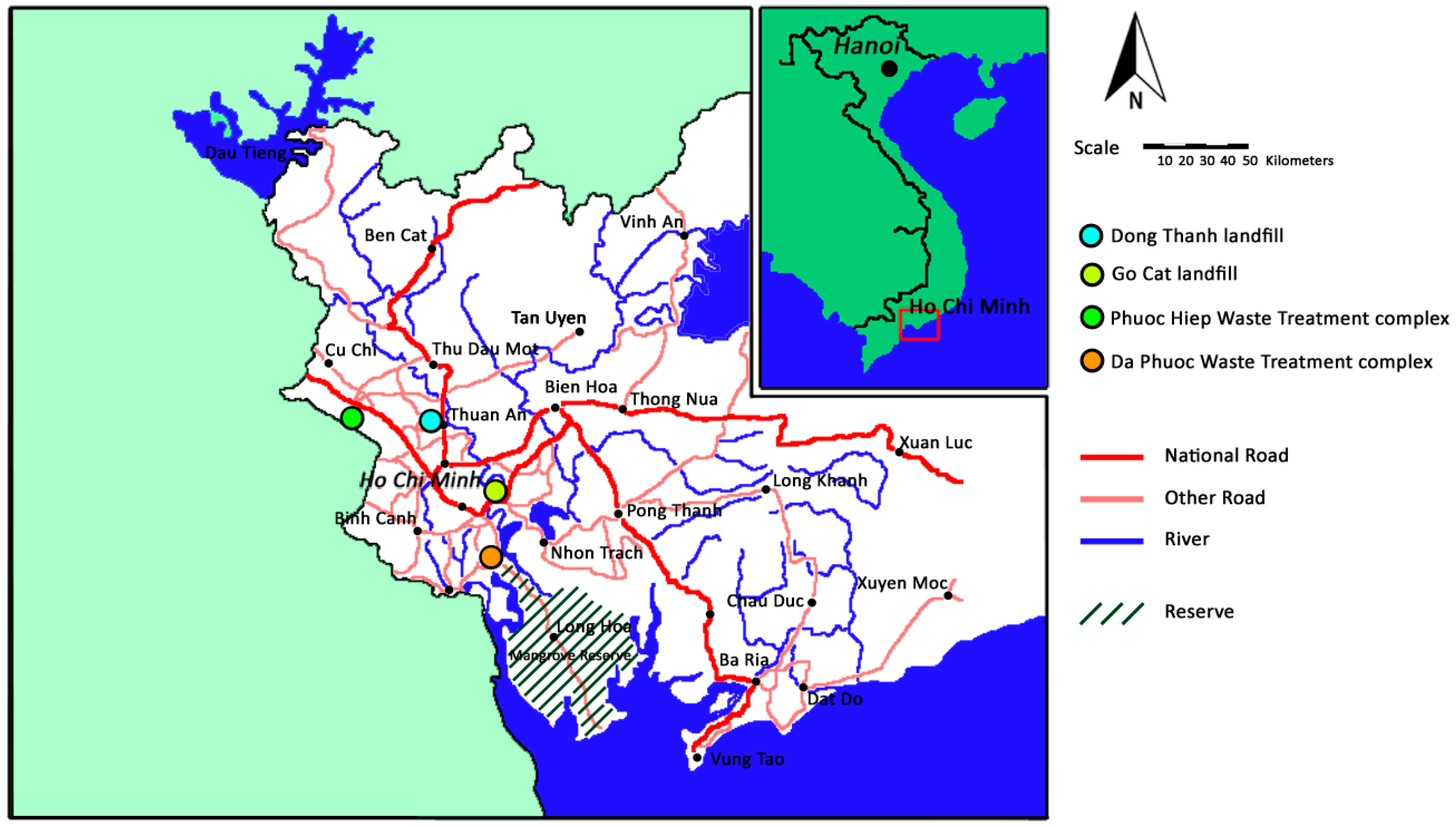
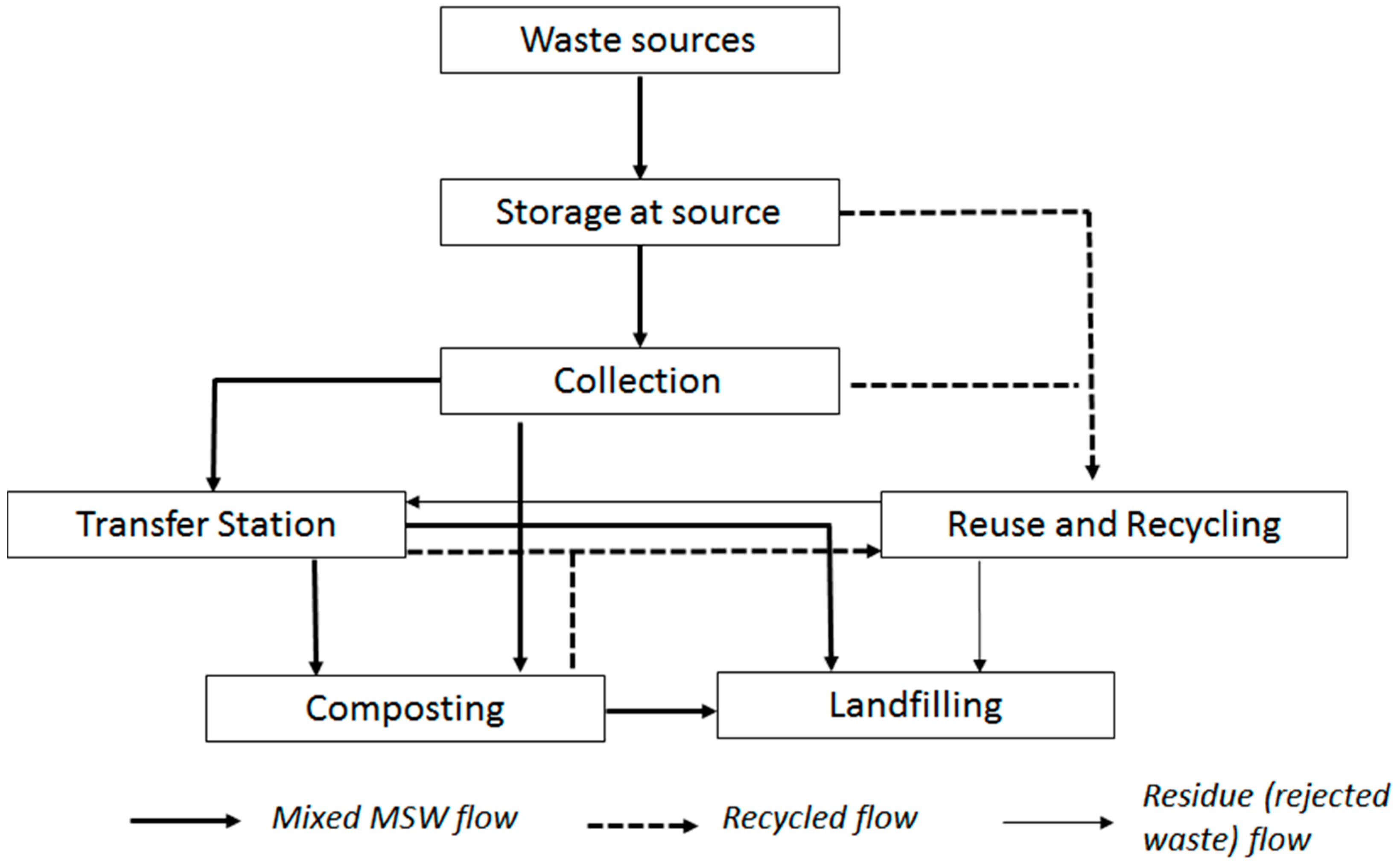
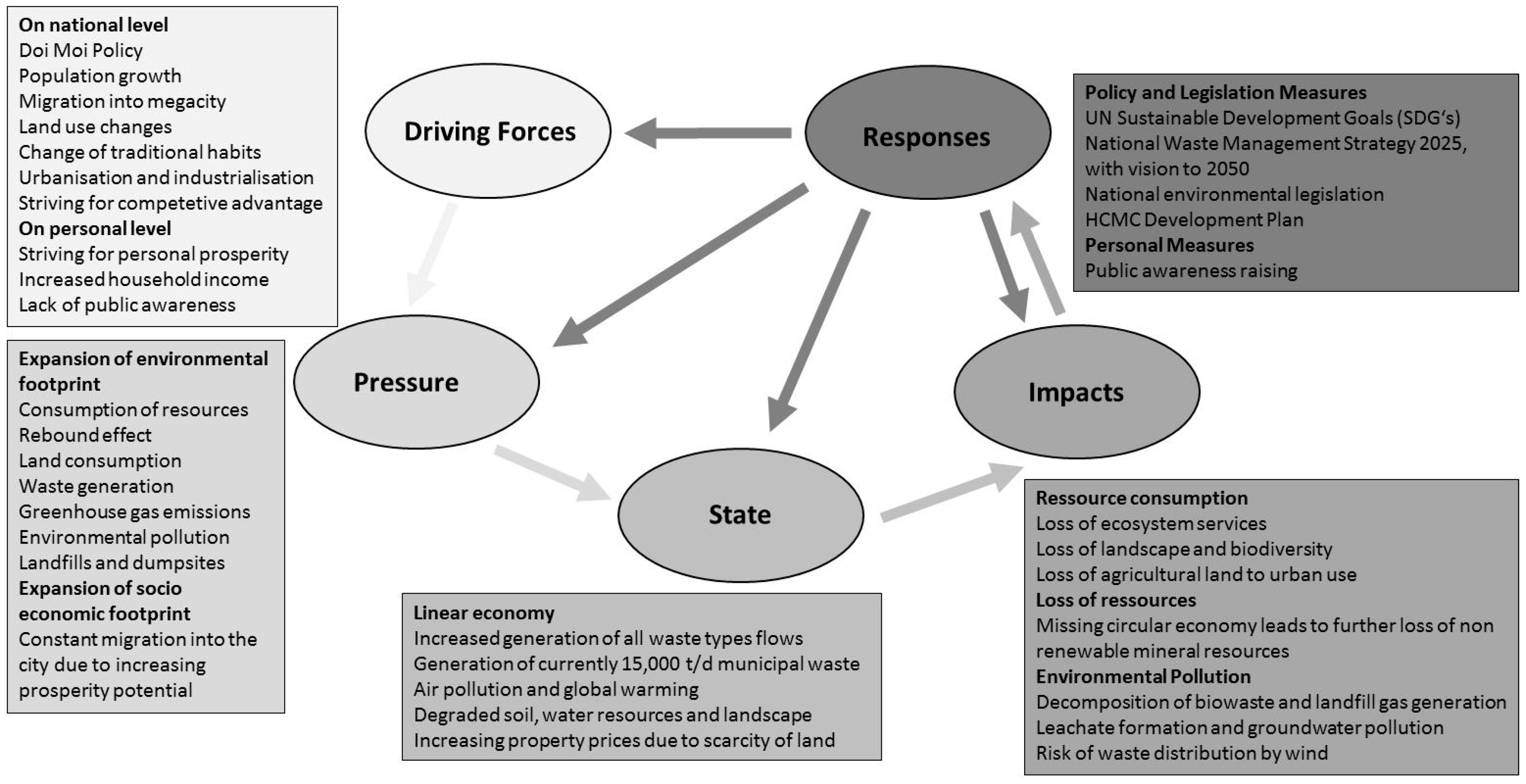
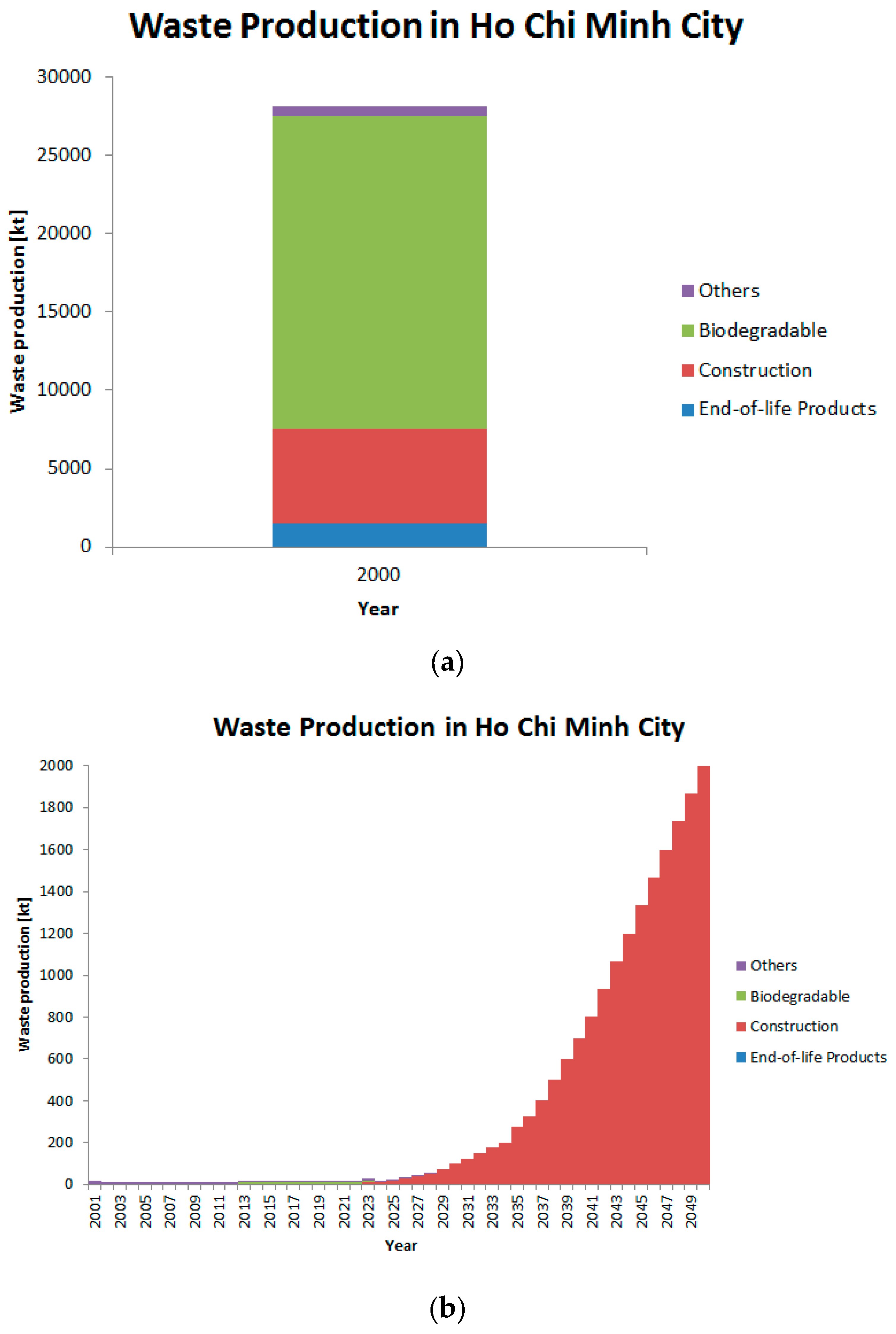
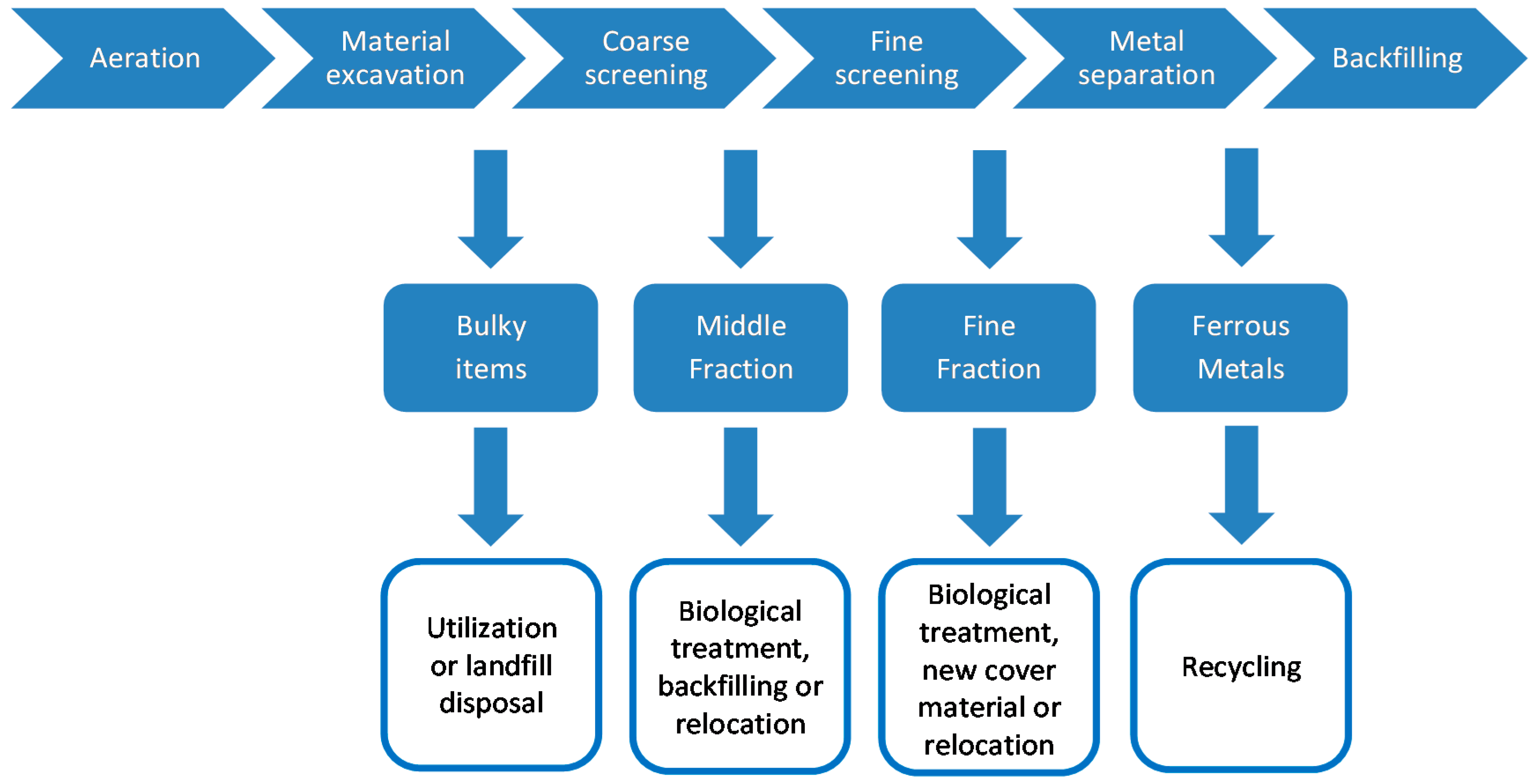


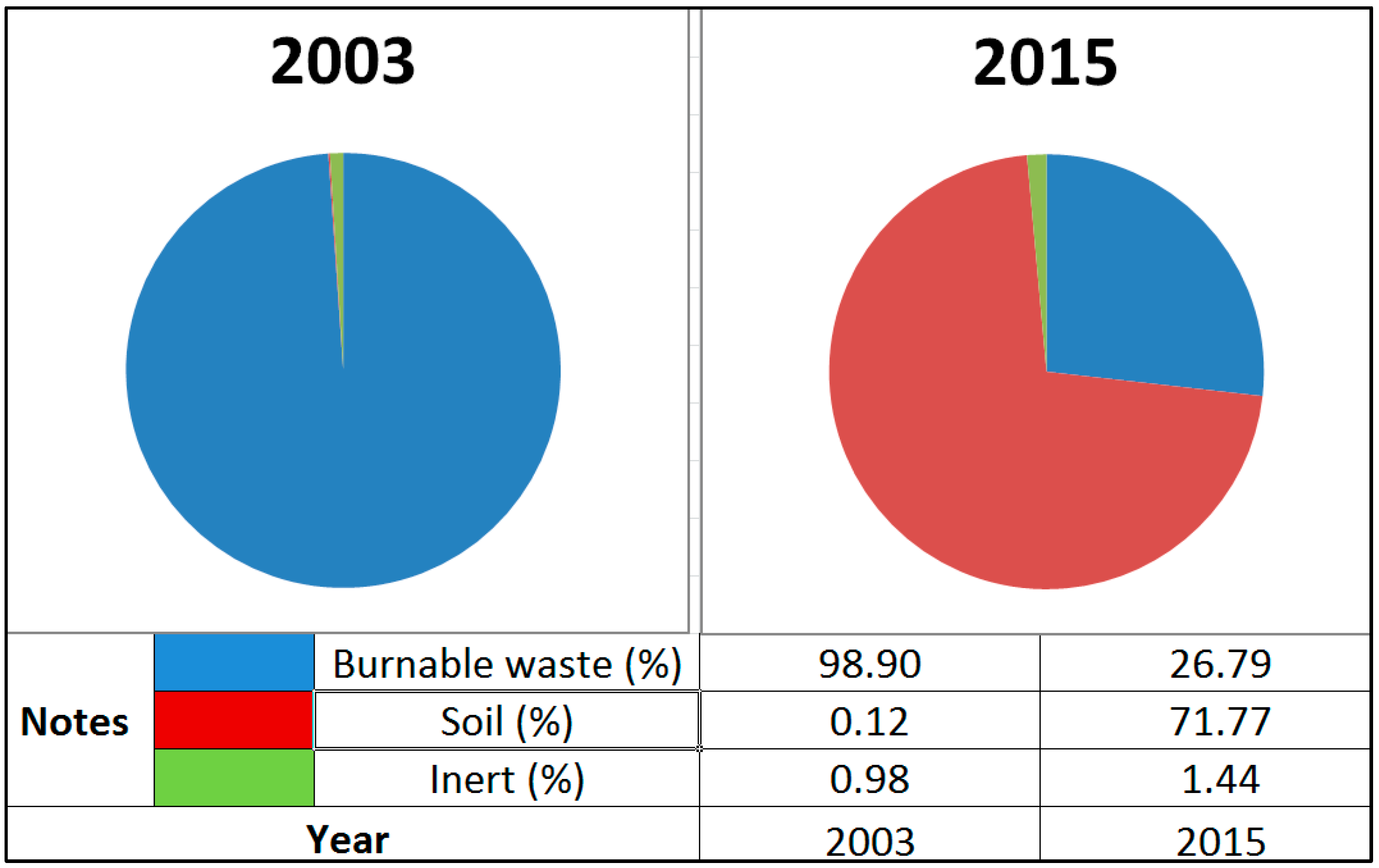

| Characteristics | Dong Thanh | Gò Cát | Phuoc Hiep | Da Phuoc |
|---|---|---|---|---|
| Operation period | 1991–2002 | 2000–2007 | Phuoc Hiep I 2003–2006 | since 2007 |
| Phuoc Hiep 1A 2007–2008 | ||||
| Phuoc Hiep II since 2008 | ||||
| Phuoc Hiep III 2013–2014 | ||||
| Surface | 43.5 ha | 25 ha | 45 ha (I + IA), 99 ha (II) *, 7.2 ha (III) | 128 ha ** |
| Disposal volume (designed) | 3.2 mil tons | 5.8 mil tons | Phuoc Hiep I 9.2 mil tons | 10.8 mil tons |
| Phuoc Hiep 1A 1.7 mil tons | ||||
| Phuoc Hiep II 18 mil tons | ||||
| Phuoc Hiep III 4.4 mil tons | ||||
| Distance to HCMC | 25 km | 18 km | 48 km | 24 km |
| Component | Gò Cát Landfill in 2003 [11] | Phuoc Hiep Landfill in 2007 [12] * | Transfer Station in 2009 [13] | Phuoc Hiep Landfill in 2014 [3] |
|---|---|---|---|---|
| Organics | ||||
| Food waste | 70.84 | 38.10 | 85.81 | 61.3–68.9 |
| Paper | 1.04 | 1.70 | 4.18 | 3.2–4.2 |
| Cardbord | 0.66 | n.d. | ||
| Plastics and nylon | 16.03 | 30.40 | 5.70 | 16.1–17.3 |
| Textiles | n.d. | 10.30 | 0.83 | 4.1–6.4 |
| Tampon/napkin | n.d. | n.d. | n.d. | 3.0–4.1 |
| Rubber | 0.42 | 2.4 | 0.12 | 0.4–1.6 |
| Leather | 0.3 | 0.2 | 0.07 | |
| Yard waste | 1.22 | 13.3 | 0.38 | n.d. |
| Wood | 1.15 | 0.5 | 0.34 | 0.5–0.6 |
| Misc. organics | 1.77 | 0.6 | 0.36 | 0.1–1.4 |
| Inorganics | ||||
| Tin cans | 0.02 | n.d. | 0.37 | n.d. |
| Other metal | 0.16 | 1.0 | 0.02 | 0.3–0.6 |
| Glass | 0.29 | 0.2 | 0.24 | 1.4–2.2 |
| Dirt, ash, etc. | 1.1 | 1.2 | 0.99 |
| Location of Waste Collection | Monthly Fee | ||
| Households in the City | Type of Waste Collection | Vietnamese Dong (VND) | US$ |
| Dowtown | Front Line | 20,000 | 0.89 |
| By road | 15,000 | 0.67 | |
| Suburban area | Front Line | 15,000 | 0.67 |
| By road | 10,000 | 0.45 | |
| Type of Waste Generating Institution | Monthly Fee | ||
| Other Customer Group | Type of Business | Vietnamese Dong (VND) | US$ |
| Type 1: Generated waste volume <250 kg/month |
| 60,000 | 2.68 |
| |||
| |||
| |||
| Type 2: Generated waste volume >250 kg/month and >420 kg/month |
| 110,000 | 4.92 |
| |||
| |||
| |||
| Type 3: Generated waste volume >1 m3/month or >420 kg/month |
| 176,800 | 7.91 |
| |||
| |||
| |||
| Year | Population | GDP Per Capita in HCMC in US$ | Waste Generation HCMC (kg/Capita/Day) | Ecological Footprint in Vietnam (GHA/Capita/Year) |
|---|---|---|---|---|
| 1980 | 1,860,000 | 384 | no data | 0.6 |
| 1985 | 2,543,000 | 444 | 0.22 | 0.6 |
| 1990 | 2,852,000 | 583 | 0.38 | 0.6 |
| 1995 | 4,640,400 | 937 | 0.58 | 0.8 |
| 2000 | 5,274,900 | 1365 | 0.77 | 0.9 |
| 2005 | 6,230,900 | 1850 | 0.77 | 1.2 |
| 2010 | 7,378,000 | 2800 | 0.88 | 1.7 |
| 2015 | 8,244,400 | 5540 | 0.90 | 1.7 |
| Year | Recovered Gas Volume (m3) |
|---|---|
| 2005 | 2,217,792 |
| 2006 | 3,296,111 |
| 2007 | 2,947,148 |
| 2008 | 2,468,869 |
| 2009 | 781,484 |
| 2010 | 601,929 |
| 2011 | 92,249 |
| 2012 | 378,772 |
| 2013 | 287,320 |
| 2014 | 638,112 |
| 2015 | 366,583 |
| Lower Heating Value (LHV) | ||
|---|---|---|
| Landfill Cell Number | Heating Value (MJ/kg) | Average Heating Value (MJ/kg) |
| 1 | 7.231 | |
| 2 | 3.889 | |
| 3 | 5.527 | 5.950 |
| 4 | 7.567 | |
| 5 | 4.512 | |
| 6 | 6.975 | |
| Strengths | Weaknesses |
| • Energy utilization potential: The waste body of Gò Cát landfill does have a certain waste-to-energy potential, even if it does not justify the deconstruction of the landfill body in monetary terms as such. Partially the incinerated material would need backfilling. This could be done at the landfill Phuoc Hiep which is still in operation. • Land recycling potential: The location of Gò Cát landfill has a large land recycling potential as the megacity needs space for its further growth. • Biomass utilization potential: Gò Cát landfill has a long term biomass utilization potential, which could be unlocked through energy crop cultivation on the capped landfill. • Authority supervision of HCMC landfills: Generally, environmental supervision of the monitoring of the landfill sites in operation is done by the authorities. Closed landfill sites are monitored under supervision of the authorities. | • Material utilization potential: The waste body of Gò Cát landfill does not contain a large potential for a material use in the sense of the European waste management hierarchy. • Landfill gas utilization potential: The landfill gas potential of Gò Cát is exhausted due to decomposition of the biodegradable waste proportion and the blocked gas collection system. • Landfills situation: HCMC landfill sites are not maintained state-of-the-art, both operating and closed sites. At the closed sites, the landfill capping is not applied properly, the leachate collection system works only temporarily, both causing emissions. At the operating sites are problems with air emissions. • Handling of hazardous waste: Hazardous waste is often dumped with MSW. About 90% of industrial hazardous waste in HCMC is untreated and often burned. Hazardous waste could appear when the landfill is deconstructed. |
| Opportunities | Threads |
| • Monetary valorization All discussed re-use options are technically feasible and contain a monetary valorization potential. The largest margin could be achieved through landfill deconstruction with subsequent land recycling. The use of recycled land would reduce the land consumption. • Pilot project Gò Cát landfill could become a pilot project for: (a) landfill deconstruction with subsequent land recycling; or (b) after-use through energy crop cultivation and utilization in a biogas plant. With this kind of attention Gò Cát landfill could have a lighthouse function for Vietnam, as well as for capacity building of environmental awareness and environmental qualification (teaching). • Investors There are already interested investors to obtain the recycled land. | • Insufficient Landfill Capacity The high economic growth and progressive urbanization mean waste continues to rise. There is a risk that the development of the National Strategy for integrated waste management cannot keep up with the rapid social and economic changes. • Management In the authorities might lack the will and/or options against state-owned enterprises and foreign investors to enforce the existing laws. • Investors There is a financial risk for the investors as the subsoil situation of Gò Cát landfill is not yet investigated. Even Gò Cát landfill was built with a basic sealing according to international standards, there could appear polluted soil below the landfill location which must be decontaminated. |
© 2017 by the authors. Licensee MDPI, Basel, Switzerland. This article is an open access article distributed under the terms and conditions of the Creative Commons Attribution (CC BY) license ( http://creativecommons.org/licenses/by/4.0/).
Share and Cite
Schneider, P.; Anh, L.H.; Wagner, J.; Reichenbach, J.; Hebner, A. Solid Waste Management in Ho Chi Minh City, Vietnam: Moving towards a Circular Economy? Sustainability 2017, 9, 286. https://doi.org/10.3390/su9020286
Schneider P, Anh LH, Wagner J, Reichenbach J, Hebner A. Solid Waste Management in Ho Chi Minh City, Vietnam: Moving towards a Circular Economy? Sustainability. 2017; 9(2):286. https://doi.org/10.3390/su9020286
Chicago/Turabian StyleSchneider, Petra, Le Hung Anh, Jörg Wagner, Jan Reichenbach, and Anja Hebner. 2017. "Solid Waste Management in Ho Chi Minh City, Vietnam: Moving towards a Circular Economy?" Sustainability 9, no. 2: 286. https://doi.org/10.3390/su9020286







